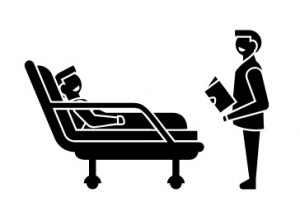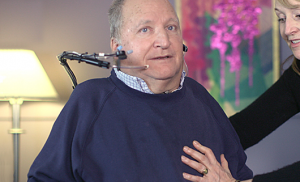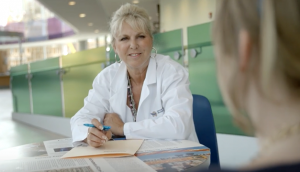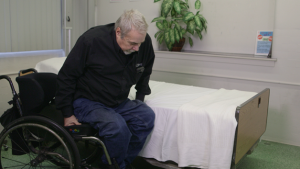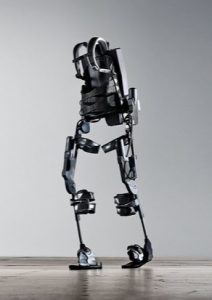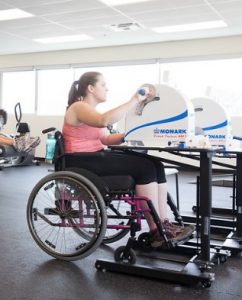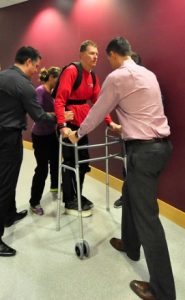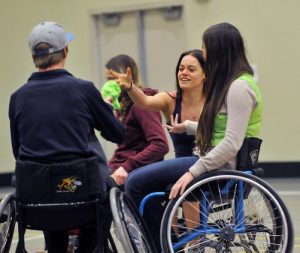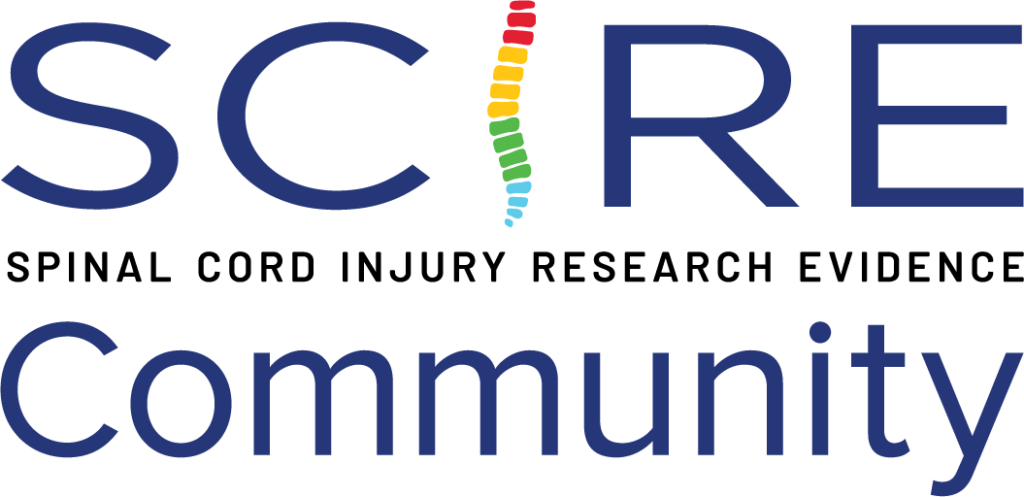Author: SCIRE Community Team | Reviewer: Shannon Sproule | Published: 25 September 2017 | Updated: ~
Rehabilitation is an important part of recovery after spinal cord injury (SCI). This page explains what rehabilitation is and what to expect in rehabilitation after an SCI.
Key Points
- Rehabilitation is the process of recovering function and independence after a spinal cord injury.
- Rehabilitation is an active process where a person works together with their family and healthcare team to achieve their rehabilitation goals.
- Rehabilitation programs involve many different activities, such as managing medical problems, developing mobility and independent living skills, adjusting to the injury, and planning for return to the community.
- How long a person stays in rehabilitation depends on many factors, such as the characteristics of the injury, where they live, and how much support they have. In Canada, the average stay in rehab after a traumatic SCI is around 70 to 80 days.
Rehabilitation is the process of recovering function and independence after a spinal cord injury (SCI).
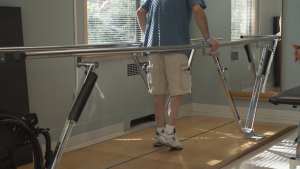
Part of rehabilitation may focus on developing mobility skills, like walking or using a wheelchair.1
“Rehabilitation” (or simply “rehab”) describes both this process and the health services (like the programs, hospitals, and centers) that support it.
After leaving an acute care hospital after SCI, most people move to a “rehabilitation center” or ‘rehabilitation hospital’, where they focus on recovering and developing the skills for living with an SCI long-term.
Rehabilitation is tailored to each person’s unique needs and goals. It may involve medical and nursing care, rehabilitation therapies (like physiotherapy, occupational therapy, or respiratory therapy), and a number of other health services to help ease the transition from the hospital to the community.
Susana describe her experience with regaining hand function through rehabilitation.
Listen to Lidia describe what going through rehabilitation was like for her.
Rehabilitation may be provided in several forms based on the needs of the person and their environment.
Staying overnight in rehabilitation (Inpatient rehabilitation)
Inpatient rehabilitation is when a person stays overnight at a rehabilitation centre. They receive full-day programming including medical, nursing, and therapy services and assistance with meals, bathing, and dressing. Inpatient rehabilitation is the most intensive type of rehabilitation.
Visiting rehabilitation for select services (Outpatient rehabilitation)
Outpatient rehabilitation is when a person who is living in the community visits a rehab centre or clinic for regular services. Outpatient rehabilitation may be used by people who have already completed inpatient rehabilitation or do not need to stay overnight in rehab.
SCI rehabilitation programs
Specialized SCI rehabilitation programs may be available in larger communities in addition to more standard services. These programs offer SCI-specific services like special clinics for wheelchair seating, sexual health, and employment counselling.
Community-based rehabilitation
Community-based rehabilitation involves receiving services from a community-run rehabilitation centre. These centres offer support for rehabilitation within a community-oriented local setting and may provide a wide variation of different services based on the centre, local environment, and healthcare system. Community-based rehabilitation is an important component of rehabilitation, especially in places where formal healthcare services are unavailable or inaccessible.
The SCI and most other early medical problems are typically diagnosed and treated in the acute care hospital before rehabilitation. However, medical testing and imaging may also be done during rehabilitation to monitor healing and to diagnose any new health problems. Testing done in rehabilitation may include:
- The International Standards for Neurological Classification of Spinal Cord Injury exam (or ASIA Exam) is often done at several points during rehabilitation to monitor recovery.
- Physical testing includes testing for important specific physical levels related to function and independence. For example, assessing strength (more than AIS exam does), bladder control (such as residual volumes), and pain (visual analog scale). Many specific outcome measures are used.
- Outcome measures are special tests that measure progress or change in a particular area. These tests may involve verbal or written questionnaires and tests of physical function (like walking for a set length of time or wheelchair skills) or Psychological adjustments (like quality of life measures). Common tests include the Functional Independence Measure and the Spinal Cord Independence Measure. These tests are often repeated multiple times, which is an important way of measuring progress over time.
Medical testing and imaging
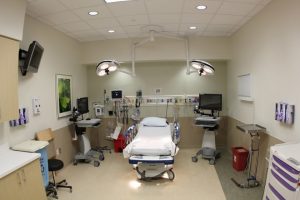
After being treated for acute medical conditions in the emergency room, various assessments and medical tests may be performed.3
Most medical testing and imaging is done in the acute care hospital before rehabilitation. However, some of these tests may be done to monitor changes or if new health problems arise. These may include:
- X-rays
- Computed tomography (CT or CAT scan)
- Magnetic resonance imaging (MRI)
- Myelogram
- Electrophysiological testing
- Blood tests
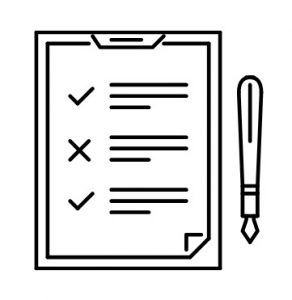 The goals of rehabilitation are different for everyone. Every person has a unique spinal cord injury and different priorities about what is important to them. Goal setting can help focus efforts on what each person really wants to achieve during rehabilitation.
The goals of rehabilitation are different for everyone. Every person has a unique spinal cord injury and different priorities about what is important to them. Goal setting can help focus efforts on what each person really wants to achieve during rehabilitation.
Goal setting in rehabilitation involves developing specific and measurable goals together with the input of the healthcare team and family. A specific plan is then agreed upon to work towards achieving those goals.
The main focus of rehabilitation is to develop the skills needed to live with an SCI. This focuses on living with or without assistance either in an independent residence or a facility. Rehabilitation involves a wide range of activities and therapies, including those that focus on:
- Managing medical problems

- Supporting adjustment to the injury
- Developing mobility and independent living skills
- Planning for return to the community
The activities that make up a person’s rehabilitation depend on the person, their SCI, their discharge environment, support and funding, as well as personal priorities.
A number of medical problems may be present during rehabilitation. Medical problems are addressed through the care of your healthcare team and by developing the knowledge and skills to manage these problems long-term.
- Skin care involves caring for the condition of the skin and treating and preventing wounds and pressure ulcers. This may involve pressure relief techniques, specialized seating, and nutritional changes along with skin care education. Treatment for active wounds may involve wound dressings or treatments, medications, equipment or mobility recommendations to address possible causes.
- Bowel care involves a variety of physical, dietary, and medication treatments for managing bowel problems. It will also involve learning about how to manage bowel care once you leave rehab.
- Bladder care involves regularly emptying the bladder using catheters or other techniques, treating problems like urinary tract infections, and staying hydrated. It also involves learning how to manage bladder care once you leave rehab for long term bladder health.
- Pain management involves trying different medications, physical strategies, and other techniques to manage pain effectively.
- Spasticity care involves learning about spasticity and using treatments like medications, exercise, and positioning to reduce spasticity.
- Respiratory (breathing and coughing) care may involve breathing and coughing exercises, care for lung infections, and learning to use equipment and manage breathing once you leave rehab.
- Autonomic dysreflexia management involves recognizing autonomic dysreflexia and understanding how to prevent and treat it.
-
Blood pressure care may involve learning to manage and care for orthostatic hypotension and other blood pressure problems using medications, exercise, compression garments, or change to salt and fluid intake.
- Sexual and reproductive health is an important part of health. Consultation with sexual health clinicians can be an important part of rehab after SCI.
- Brain injuries and concussions can often happen at the same time as an SCI. Care for these injuries involves consulting with brain injury specialists and receiving treatments for these injuries.
- Other injuries and issues may arise during rehabilitation that need to be managed such as muscle or bone issues, nerve entrapment, carpal tunnel and upper extremity dysfunction.
SCI is a life-changing event that can lead to a variety of different emotional and psychological responses that are unique to each person. It is common for people to experience sadness, disbelief, anger, grief, confusion, helplessness, anxiety, loss of self-image, or difficulties coping. Other individuals may develop mental disorders like depression, substance abuse, or post-traumatic stress disorder. There is no predictable response that everyone will have after experiencing an SCI; it is different for everyone.
Support for adjustment and coping during rehab may include:

In addition to providing direct medical care, your healthcare team can provide education on transitioning into rehab.8
- Assessment and treatment from mental health professionals like social workers, counsellors, or psychologists.
- The rest of the health team, like your doctors and nurses, are also an important resource for bringing up mental health questions or concerns. They can provide you with resources and referrals for support services, counselling, and medications.
- Support from loved ones like family and friends can also be an important part of managing after an SCI.
- Many SCI organizations provide peer-support programs or groups, where you can meet with other people who have experienced an SCI.
- Other things like taking an active role in your treatment and recovery, being honest about your feelings and what you need to manage your health and wellness, seeking out positive and active ways of coping, seeking out treatment for problems you identify, and staying socially engaged can all be helpful ways of managing after the injury.
Refer to our article on Depression After Spinal Cord Injury for more information.
Hear Ivan’s advice on being honest with oneself after an SCI.
Listen to Louise speak about the impact of seeking social support after an SCI.
There are a number of mobility and independent living skills that play an important role in everyday life. These skills may be practiced during physiotherapy, occupational therapy, and other daily activities in rehabilitation.
- Bed mobility is the ability to move between different positions while lying in bed. This includes skills like turning while in bed or moving into a sitting position at the edge of the bed.
- Sitting balance is an important part of many other skills like transfers, getting up to standing, and wheelchair skills. It may be worked on specifically or incorporated into other exercises.
- Transfers are techniques for safely moving between different positions and surfaces. For example, moving from a bed to a wheelchair is a type of transfer. Transfers may also involve the use of mechanical lifts, transfer boards, and the direction of caregivers.
- Selecting a wheelchair and other equipment is an important part of rehabilitation. Therapists work with each person to select a wheelchair based on their needs. It should be properly fitted to avoid pressure sores, ensure comfort, maintain posture, function, and prevent complications. Other equipment like beds, mattresses, and devices for toileting and bathing are also important for independent living.
- Wheelchair skills may include a variety of different techniques such as going up sidewalk curbs safely and opening doors. Wheelchair skills are usually taught one-on-one or in class.
- Walking skills may be practiced in rehabilitation. This may involve a variety of different strategies, which usually progress from standing to stepping to walking. It may also involve strengthening exercises, assistive devices like canes, walkers and parallel bars, and braces and orthotics. Some facilities use special equipment such as body weight supported treadmill training and robotic exoskeletons.
- Resistance (strength) training may involve the use of pulleys, free weights, body weight, and exercise bands. People who have greater weakness may also use slings, springs or pool exercises (hydrotherapy) to help build strength during therapy, group classes, or on their own.
- Aerobic exercise is exercise that trains the heart, lungs, circulatory system through repetitive and movements for a long time. Aerobic exercise is a very important part of maintaining cardiovascular fitness. Aerobic exercise in rehabilitation may involve activities like arm cycling, functional electrical stimulation cycling and supported walking using parallel bars or body-weight support.
- Electrical stimulation, including functional electrical stimulation, can be used to activate muscles for exercise and strengthening. Stepping, cycling, reaching, hand to mouth, or grasping exercises are common functional activities done together with electrical stimulation.
- Activities of daily living are self-care tasks like bathing, toileting, dressing, feeding, and grooming. For many people with SCI, new or modified techniques for doing daily tasks may be needed. This may involve learning how to use new techniques, special equipment, or learning how to direct caregivers on how to do these tasks.
Returning to community living after an SCI involves planning for suitable living arrangements after rehab and for return to their previous activities. This is done with support from the whole health team and may be led by a social worker or discharge planner. During rehabilitation, activities that help with return to the community may include:
- Planning for leaving the hospital involves arranging for home modifications, alternative housing, or referral to a long-term care facility or outpatient services.
- Community resources help individuals locate and utilize services. Access to community groups, peer mentors, transit, home support, personal care assistants, nurses and therapists can assist those returning to community living.

- Managing finances may be another important component of planning for return to the community. It is important to be aware of any disability or tax changes. Social workers can assist individuals to identify these things and plan for any changes.
- Returning to work depends on the person and their occupation. During rehabilitation, patients often consult a vocational counsellor who can help plan for return to work.
- Returning to recreation and leisure activities may involve working with a recreational therapist on skills and strategies to return to important recreation activities.
- Driver rehabilitation involves learning how to drive with different levels of physical function, including how to make modifications to vehicles and to get re-tested with a modified license if that is needed.
A team of health care professionals and specialists works in collaboration with an individual and their family members to meet the goals and objectives of Rehabilitation.
- Physiatrists (Physical Medicine and Rehabilitation Physicians) are medical doctors who specialize in rehabilitation and provide care to individuals with SCI. They help determine if an individual should participate in rehabilitation and treat many of their physical issues.
- Specialist Physicians offer consultation and specialized treatment related to SCI. These include General Surgeons, Neurologists (nervous system), Urologists (urinary system), Plastic Surgeons (restoration or reconstruction), Orthopedic Surgeons (bone, muscle, and joint), and Neurosurgeons (nerve and brain).
- Nurses provide consultation services and various forms of direct care such as pain management, bowel and bladder routine management, wound management, and skin care.
- Pharmacists specialize in the management of medications. They prepare and dispense medications, and provide consultation services to patients and other professionals.
- Physical therapists (Physiotherapists, PTs) specialize in helping people to maximize their movement and functional independence. Physiotherapists work with individuals on mobility skills like transfers, walking, wheelchair skills, arm movements, the treatment of wounds and pain, and may also prescribe mobility devices.
- Occupational therapists (OTs) specialize in helping people to meet their goals for daily living and functional activities. Occupational therapists work with individuals on developing techniques for daily tasks like bathing, dressing, and eating. They also assess the safety and accessibility of living spaces and prescribe equipment like wheelchairs and braces.
- Speech-language pathologists (SLPs) specialize in improving speech and swallowing ability, dealing with problems associated with breathing assistance during mechanical ventilation and tracheostomies, and developing communication skills.
- Therapy assistants (Physical Therapy Assistants, Occupational Therapy Assistants, Speech-Language Assistants, Rehabilitation Assistants) work under the supervision of physical therapists, occupational therapists, and speech-language pathologists. During rehabilitation, they may assist with sitting, self-care, and other therapy tasks.
- Respiratory therapists (RTs) specialize in cardiopulmonary (heart and lungs) treatments related to oxygen delivery, suctioning, and mechanical ventilation.
- Recreation therapists specialize in developing the abilities needed to participate in leisure activities.
- Social workers specialize in the provision of community resources, support, and counseling related to recovery from mental disorders, and may assist in planning care after hospitalization.
- Psychologists specialize in the provision of mental health assessments, counselling and psychotherapy for mental disorders, and additional support in coping with psychological or emotional problems.
- Dieticians specialize in managing the nutritional needs of individuals and groups. They are also involved in meal planning, nutritional assessment and dietary education.
- Sexual health clinicians specialize in assisting individuals with a meaningful sexual life after illness or injury.
- Spiritual care professionals (Chaplains) provide counselling related to spiritual, emotional or religious needs.
- Vocational rehabilitation counsellors assist individuals in returning to work.
- A peer mentor is a person with SCI who provides support during rehabilitation by describing their own experiences in adjusting to life after SCI.
How long you stay in rehabilitation depends on many factors, such as the characteristics of your injury (whether it is complete or incomplete and the level of injury), where you live, and whether you develop new medical problems (such as a pressure ulcer) during rehabilitation.
In Canada, the Rick Hansen Spinal Cord Injury Registry collects and analyzes information from participating hospitals and rehabilitation centers for people with traumatic SCI. The most recent statistics from 2016 show that in Canada:
- People with paraplegia stay in inpatient rehabilitation for an average of 72 days
- People with tetraplegia stay in inpatient rehabilitation for an average of 83 days
However, these statistics are averages of the whole population and every person and situation is different. Speak to your health provider for more information.
There are several places that a person may go after leaving rehabilitation. Leaving the hospital is called discharge. Sometimes, people may also move between different hospitals during rehabilitation. Before leaving the rehabilitation facility, some individuals stay overnight to adjust to their new arrangements and make sure everything is safe and easy to use.
Home
Some people will return home to the community after rehabilitation. Often, home modifications are needed to make the home accessible and safe for someone who uses a wheelchair or has different accessibility needs than they did before. People who return home from inpatient rehabilitation often may also receive outpatient rehabilitation services for continued care.
Another healthcare or assisted living centre
Other individuals may go to a long-term or transitional care facility, or an independent living facility within the community.
The process of rehabilitation is complex and can vary in length for many reasons, including characteristics of the injury, where the individual lives, and how much support the individual has. With the aid of specialists from your rehabilitation team, programs can be tailored to help you achieve goals such as developing functional independence, mobility, and adjusting to life with an SCI.
To learn more about rehabilitation and how you can reach your personal goals, speak to your main healthcare provider.
For a review of how we assess evidence at SCIRE Community and advice on making decisions, please see SCIRE Community Evidence.
Parts of this page have been adapted from the SCIRE Professional “Rehab: From Bedside To Community” page:
Eng JJ. (2014). SCIRE Systematic Review Process: Evidence. In Eng JJ, Teasell RW, Miller WC, Wolfe DL, Townson AF, Hsieh JTC, Connolly SJ, Noonan VK, Loh E, McIntyre A, editors. Spinal Cord Injury Rehabilitation Evidence. Version 5.0: p 1-79.
World Health Organization: World Report on Disability 2011. Geneva, Switzerland, World Health Organization, 2011.
Rick Hansen Institute. Rick Hansen Spinal Cord Injury Registry: A look at traumatic spinal cord injury in Canada in 2016. Published May 2017. Accessed September 2017.
Kirshblum SC, Burns SP, Biering-Sorensen F, Donovan W, Graves DE, Jha A, Johansen M, Jones L, Krassioukov A, Mulcahey MJ, Schmidt-Read M, Waring W. International standards for neurological classification of spinal cord injury (revised 2011). J Spinal Cord Med. 2011 Nov;34(6):535-46. doi: 10.1179/204577211X13207446293695.
Wade DT. Goal setting in rehabilitation: an overview of what, why and how. Clin Rehabil. 2009 Apr;23(4):291-5.
Image credits:
Image by SCIRE Community Team
- Image by SCIRE Community Team
- Aimee in bed ©Rob Cameron, CC BY-NC 2.0
- New UPMC East: Emergency patient room ©daveynin, CC BY 2.0
- Checklist ©lastspark, CC BY 3.0 US
- Therapy ©Vectors Market, CC BY 3.0 US
- Image by SCIRE Community Team
- Image by SCIRE Community Team
- Best Shoes for Nurses ©Esther Max, CC BY 2.0
- Image by SCIRE Community Team
- Ekso Bionics Ekso ©Ekso Bionics, CC BY-ND 2.0
- Revved Up Lab ©Queen’s University, CC BY-NC-ND 2.0
- Budget ©Vectors Market, CC BY 3.0 US
- Trevor Green ©Simon Fraser University – Communications & Marketing, CC BY 2.0
- KPE wheelchair basketball 08 ©University of the Fraser Valley, CC BY 2.0
- Calendar ©tezar tantular, CC BY 3.0 US






